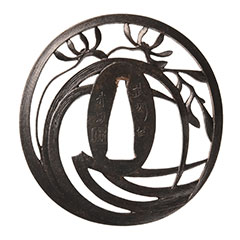
保存刀装具Hozon Tousougu
赤坂(印)蘭透鍔/鐔Akasaka(stamp) Ran(Orchid) Sukashi Tsuba
No.641615銘 武州住赤坂(印)蘭透鍔Mei Busyu jyu Akasaka(stamp) Ran(Orchid) Sukashi Tsuba
ご成約Sold
- 銘表Mei-Omote
- 武州住赤坂(印)武州住赤坂(印) Busyu jyu Akasaka(stamp)
- 時代Period
- 江戸時代Edo period
- 法量Size
-
縦 7.70cm 横 7.40cm 切羽台 0.48cm 中心孔縦 2.83cm 中心孔横 0.94cm 重量 90.0g
Length 7.70cm Width 7.40cm Seppadai 0.48cm Nakaoana-Length 2.83cm Nakaoana-Width 0.94cm Weight 90.0g
- 説明Drscription
- 竪丸形 鉄地 肉彫地透 角耳小肉
赤坂派は初代・二代の忠正親子が江戸へ寛永頃移住し、尾張透の手法と京透の工法に工夫を加えて鐔を制作し、幕末頃まで栄えた。初・二・三代(古赤坂)は、鉄地の鍛が良好で造形は丸形、丸耳で厚手のものが多く、角丸風造りも見られる。四代目忠時の頃から鐔もやや薄くなり、精巧な造込となった。赤坂という呼称はこの一門の職人たちの居住地(現在の東京都港区の赤坂一帯)から用いられた。Tatemarugata Tetsuji Nikuborijisukashi Kakumimikoniku
The first and second generations of the Akasaka school, Tadamasa and his son, moved to Edo around the Kan'ei era, where they produced tsuba by adding ingenuity to the Owari-tou method and the Kyo-tou method, and prospered until the end of the Edo period. The 1st, 2nd and 3rd generation (Ko-Akasaka) have good forging of the iron base, and many of them are round and thick with round ears. From around the time of Tadatsuki IV, the tsuba became a little thinner and became more elaborately crafted. The name Akasaka was used from the place where the craftsmen of this family lived (present-day Akasaka area in Minato Ward, Tokyo).


